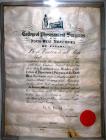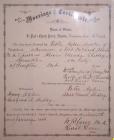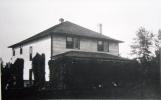2
With the advancement of the railroad came the influx of settlers. For these immigrants, the mounted police represented a force reminiscent of European law enforcement, one that demanded respect, and provided them with a sense of safety and security in a foreign land.For the police officer, his duties were complementary to the development of a new settlement and included tasks such as the fire brigade, bylaw enforcement, judge and jury, and medical treatment. Officers often sought the companionship of the local spinsters by attending and coordinating events for the sole purpose of match-making.
3
The Spread of Dr. Aylen's Force4
Dr. Peter Aylen's Medical Certificate1886
Fort Saskatchewan, Alberta
 Credits:
Credits:Fort Saskatchewan Museum / 81-8-3a
5
Sporting a Degree of Medicine from the College of Physicians at McGill University, Dr. Peter Aylen came to Fort Saskatchewan as a Junior Assistant Surgeon for 'G' Division on July 1, 1886.Within a short time, he saw his duties embracing the civilian community. As an officer of the force, he practiced medicine from the North West Mounted Police Hospital, treating the police detachments and civilians, Indian and White alike.
Soon his skill as a surgeon proceeded him and he provided surgical service for the two provinces of Alberta and Saskatchewan. He received the title of Honourary Surgeon of the North West Mounted Police at Fort Saskatchewan on November 30, 1897.
6
The North-West Mounted Police Hospital8
The only hospital in the district was operated by the North West Mounted Police. The posted Doctor treated many patients from the community as well as the force. The original building was an old abandoned settler's dwelling about ½ mile from the barracks.In 1888, a devastating fire burned the hospital to the ground. Shortly after, plans for a new facility were under way, but were not completed until May of 1894. It was built on the top of the hill, North West of the old court house. In Griesbach's annual report on the improvements to the barracks, he stated:
10
"It is a two-story building 28 x 30 with a basement and a hot air furnace complete, it has on the first floor a surgery, the large ward with 6 beds, one small ward with 3 beds, one hospital orderly's room and one bathroom.The upper floor is not connected with the lower floor, but is entered by an outside stairway, so that it can be isolated and used in case of fever or other contagious diseases break out".
11
Family Roots13
Dr. Aylen, like other members of the North West Mounted Police, soon fell in love and on November 1892, wed Ms. Alice Maude Shibley from Kingston, Ontario. She was the daughter of Schuryler Shibley of the Township of Porland and Mary Anne Greer of the Township of Camden.Soon after the wedding, a family was underway and the couple raised eight children; Keith, Gerald, Bernard, Douglas, D'Arcy, Kathleen, Naomi, and Patricia.
All through his residency in Fort Saskatchewan, Dr. Peter Aylen's efforts for a healthy community was more than medical. After his resignation from the North Mounted Police Force, Dr. Aylen was appointed Mayor. The success of his term was reflected in the fact that he received a letter from Fort Saskatchewan Trade Commission requesting him to stay on as Mayor for yet another year. Among his many town improvements was the building of the Fort Saskatchewan Dam.



